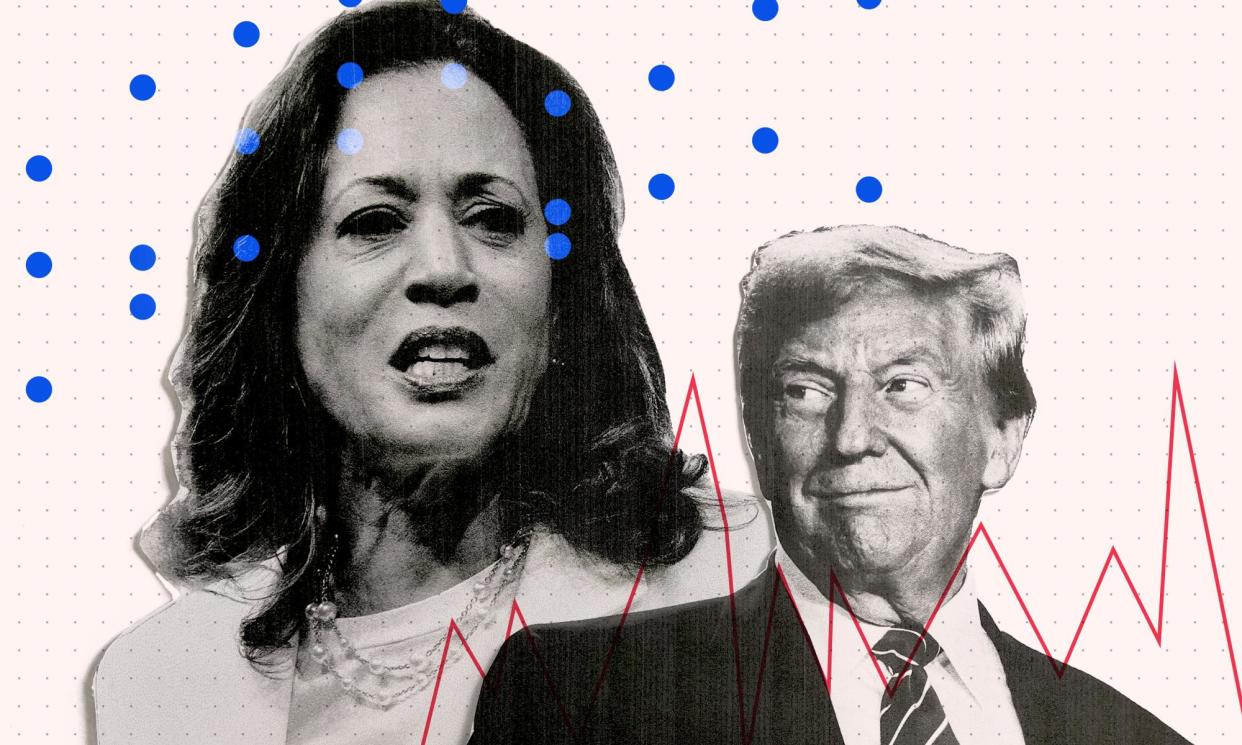Kamala Harris now leads in US polls but state-level data puts race on knife-edge

National polls for the US presidential race have been upended ever since Kamala Harris took over from Joe Biden to run against Donald Trump.
While Biden was trailing the Republican former president nationally and in many crucial swing states, Harris has gained about three points in national polls since becoming the nominee.
The Guardian’s poll tracker assesses polls over a rolling 10-day period. It now has Harris leading nationally by about two points.
But when comparing this performance with previous elections, data from RealClearPolitics reveals Harris’s lead over Trump is weaker than those of his previous opponents. As of 30 August in their respective campaigns, Hillary Clinton led Trump by five points in 2016 and Biden was ahead of him by 6.3 points in 2020.
But national polling is only part of the picture. Clinton lost the 2016 election despite winning more votes than Trump, because of the electoral system by which the president is elected.
Several swing states have shifted to Harris and are on a knife-edge
The US presidential election is decided by races in individual states that have a set number of electoral college votes. This means the race is decided by a handful of swing states such as Pennsylvania, Arizona and Georgia.
Looking at data from RealClearPolitics, Harris has managed to at least close the gap on, if not overtake, Trump in the swing states. This is especially evident in Georgia and Arizona, where Harris has gained more than four points since Biden dropped out of the race.
Pollsters claimed Harris’s consolidation of the Democratic base, especially with voters of colour and young people who drifted from the party in Biden’s final months as the presumptive Democratic nominee, had brought these states back into play.
Sitting ahead of Trump by a couple of points nationally is not enough to give Harris a secure lead in any of the swing states.
Trump and Harris are still within two points of each other in seven swing states – well within the margin of error for polls.
Christopher Borick, a professor of political science and director of the Muhlenberg College Institute of Public Opinion, said this was key: “We’re talking about a few points either way being critical [in this election].
“The polls weren’t incredibly far off in 2016 or 2020 but the points by which they were off were significant. Margins of error don’t acknowledge victory lines, and small errors can make a big difference.”
While this article analyses the latest polling average figures from RealClearPolitics, other polling averages from Silver Bulletin and FiveThirtyEight are giving Harris slightly larger leads in Michigan, Georgia, Nevada, Pennsylvania and Wisconsin.
Previous polling errors give Democrats cause for concern
While Harris can enjoy the favourable polling over the last few weeks, there is another uncertainty to factor in: Trump outperformed the polls in 2016 and 2020.
There were several reasons for this: a lot of people made up their minds quite late in those campaigns; many Trump voters did not tell polling companies who they were supporting; and also methodological errors led to a fundamental underestimation of Trump support.
Josh Clinton, the chair of the American Association for Public Opinion Research (AAPOR) taskforce that produced a study on 2020 polls, told Pew Research: “The polling error was the highest in 40 years for the national popular vote and the highest in at least 20 years for state-level estimates of the vote.”
In 2020, certain polling averages missed the result by as much as 7.7 points in the case of FiveThirtyEight in Wisconsin. The pollster had Biden leading by 1.8 points in North Carolina, while RealClearPolitics had Trump leading by just 0.2 points. In fact, Trump carried the state with a lead of 1.3 points.
The methodological errors included incorrect weighting that led to under-representation of less educated voters, as well as a lack of attention paid to voters’ recalled voting patterns. Polling companies have sought to address these in this election, for example by the wide adoption of education as an additional survey weight.
On top of these adjustments, 2022 gives people reason to hope. It was one of the most accurate years for polling in recent history, according to an analysis by FiveThirtyEight.
But with Trump in the race again, there is uncertainty.
Borick said “there may be a systemic underestimate of his support. We have seen this in our polls and I believe it reasonable to consider the possibility of a recurrence in 2024. The adjustments we made in 2020 such as weighting for educational attainment were ultimately helpful but did not fully correct for a dynamic that Trump seems to generate and is not fully understood.
“The differences are clear when Trump is on the ballot. We should be sceptical about a sample size of two presidential elections, but there does seem to be a gravitational pull in Trump elections.”
How the race shapes up
As things stand, the website 270toWin has seven states classed as a “toss-up”. It leaves the election on a knife-edge, with the Democrats forecast to win 226 electoral college votes and the Republicans, 219.
Should these states vote as predicted, Harris would only need to hold three of the Biden-backing swing states – Michigan, Pennsylvania and Wisconsin – to win with 270 electoral college voters. Trump, on the other hand, would need to flip at least two states from the Democrats to win.
This leaves 93 electoral college votes as too close to call – and uncertainty about whether polling still could be underestimating Trump support.
So while Harris can be pleased with the momentum her campaign has enjoyed over the last month, the election is still too close to call.
• This article was amended on 4 September 2024 to clarify that Harris would need to hold Michigan, Pennsylvania and Wisconsin to win 270 electoral college votes. A previous version left out Wisconsin.


